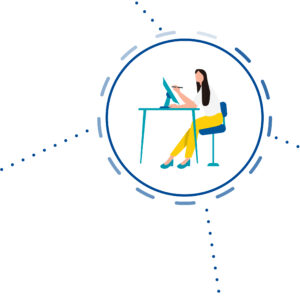Scientific Background
The autosomal recessive inherited spinal muscular atrophies (SMA) type I, II, III, IV belong to the most frequent autosomal recessive inherited diseases. The incidence is more than 1:10,000 and they have a carrier frequency of about 1:35-50. Muscular atrophy is secondary to the deterioration of the motor anterior horn cells and the motor cells of the cranial nerve nuclei in the brainstem. There are four clinical forms:
Type I (Werdnig-Hoffmann disease): The disease onset is before the age of 6 months, unsupported sitting is never learned and death usually occurs within the first years of life. Pronounced muscle weakness is in the foreground here, the muscle reflexes are mostly missing, a typical neurogenic pattern is noticeable in the electromyogram, and patients may show muscle fasciculations, especially of the tongue. The patients have good cognitive skills.
Type II (intermediate type): Sitting is learned, but patients do not learn to walk unsupported. The disease begins within the first 18 months of life. Muscle weakness progresses slower than in type I, and joint contractures and scoliosis can develop as secondary symptoms. Survival into adulthood is possible.
Type III (Kugelberg-Welander syndrome): Patients learn to walk freely, and the onset of disease is usually after the 2nd year of life. Problems with gait and weakened muscle reflexes are noticed first. Life expectancy is not substantially reduced.
Type IV (adult SMA): There is muscle weakness from the 2nd-3rd decade, but walking ability is retained and progression variable. The life expectancy is normal. Inheritance is autosomal recessive in about 30% of cases. Autosomal dominant inheritance is observed in 70%, although here the gene locus on chromosome 5 is not responsible and currently no DNA diagnostics are available.
SMA is caused by changes in the SMN1 gene (survival motor neuron gene). Two extremely homologous genes, SMN1 and SMN2, which differ from each other in only 5 base pairs, are located together with other genes and pseudogenes in a 500 kb large, inversely duplicated region on chromosome 5q13. The SMN1 copy is located towards the telomere and the SMN2 copy is centromeric. Two of the five base differences are in the region of exons 7 and 8 and are used in diagnostics to distinguish between the two genes.
Regardless of the clinical type, more than 95% of the patients carry a homozygous deletion of exons 7 and/or 8 of the SMN1 gene. A smaller proportion of patients carry this deletion on one allele and a point mutation on the other (compound heterozygous). The lack of detection of the SMN1 gene can also be due to a gene conversion from SMN1 to SMN2, which increases the number of copies of the SMN2 gene. Since such gene conversion and an increased number of SMN2 copies are more likely to be found in SMA II and III, it is assumed that SMN2 can partially compensate for the loss of SMN1. This knowledge is increasingly used for the development of therapeutic concepts for the treatment of SMA, e.g., drugs such as valproic acid, phenylbutyrate, etc., which when tested increase SMN2 functionality in vitro. Biogen's drug Spinraza® (nusinersen) has been approved as the first therapy for SMA in Europe since June 1, 2017. Spinraza® is an antisense oligonucleotide. According to available information, the drug changes the splicing of SMN2 pre-mRNA and thus leads to the formation of complete and functional SMN protein in larger quantities.
References
Groenet al. 2018, Nat Rev Neurol 14:214 / Arnold et al. 2015, Muscle Nerve 51:157 / Kolb et al. 2011, Arch Neurol 68:979 / Chang et al. 2011, Fetal Pediatr Pathol 30:130 / Lunn et al. 2008, Lancet 371:2120 / Chung et al. 2004, Pediatrics 114:e548 / Sumner et al. 2003, Ann Neurol 54:647 / Scheffer et al. 2001, Eur J Hum Genet 9:484 / Schmalbruch and Haase 2001, Brain Pathol 11:231 / Wirth et al. 1999, Am J Hum Genet 64:1340





















